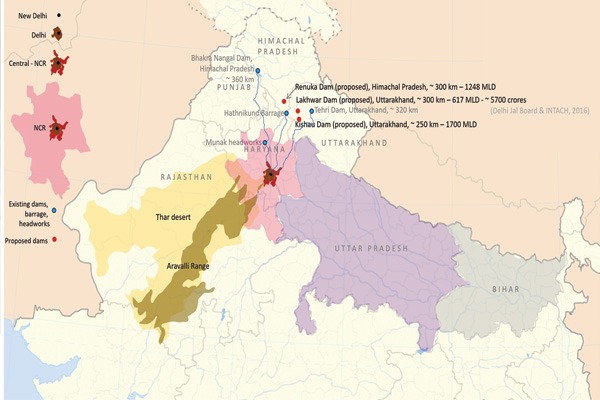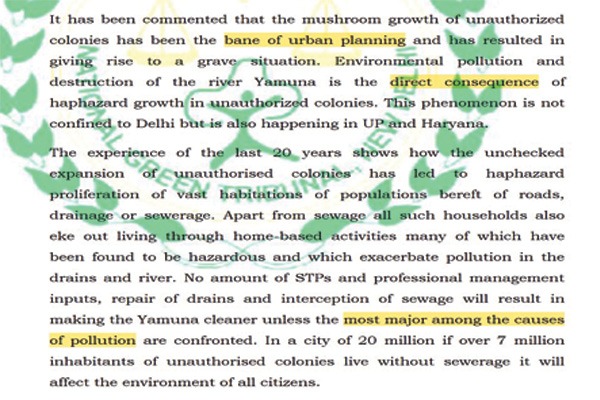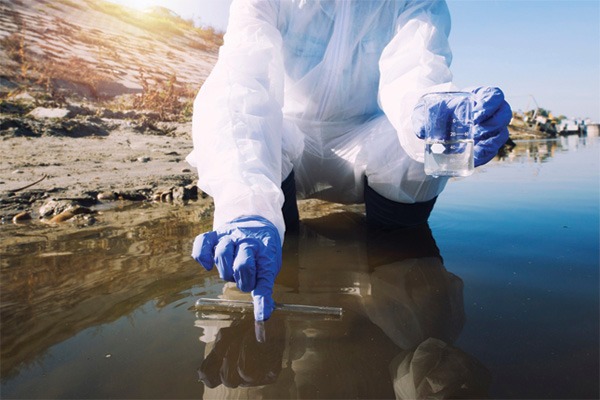
In line with the SDG 6.5 concerning Integrated Water Resources Management, this article presents a snapshot of research analysing the ‘discursive productions’ of wastewater metabolism for the National Capital Territory of Delhi or NCT. This piece draws on the author, A. Bisen’s M.Phil. Dissertation – “An Analysis of the Wastewater Metabolisms of Delhi, through their Discursive productions,” completed under the supervision of Prof. S. Vishwanath at CEPT University, Ahmedabad in 2023.
According to the American Psychological Association (2021),¹ ‘discourse’ is ‘spoken or written communication’. Discursive production could take various forms. Discursive production in this study is used in the sense that when ‘discourse’ produces or creates certain representations, it impacts or leads to outcomes and implications as seen ahead.
Deconstructing metabolism theories²,³,⁴, the wastewater has been approached through relevant questions about 3 stages of metabolism –

1) Productions
2) Circulations
3) Treatment and Reuse.
For these stages, discourse is analysed through 2 types of data:

- The discourse within a select set of government documents, master plans, legal orders.
- Semi-structured interviews of varied respondents.
Below, the article utilises select findings for the 3 stages from the main research, to illustrate discursive productions.
Numbers: The 225 LPCD (liters per capita per day) discourse
For the production stage, the study for example explores the 225 litres per capita per day (lpcd) discourse, since this ‘number’ is unique for NCT. It has often been quoted in connection to NCT’s water demand. Thus, this number and a water scarcity discourse for NCT possibly determines the sanctioning of dam projects such as the Kishau, Renuka and Lakhwar Vyasi (Figure 1). This discourse is relevant for wastewater since – wastewater volumes are calculated as 80 per cent of water supply⁵. Hence in addition to more dams, a larger lpcd number results in more wastewater treatment infrastructure. Further, these dams reduce the Yamuna’s fresh water flows, thus increasing the concentration of sewage and pollution on it.
With respect to findings – one section of data collected, reiterates how this number is taken as a given norm. However within this, there is uncertainty about what the breakup of 225 is, which differs between different sources. For example, according to the interview with TTID02⁶, the breakup for 225 includes domestic and non-domestic demand. However, the National Capital Region Planning Board (2017)⁷, breakup includes demand for commercial areas and floating populations.

Figure 1- Map illustrating existing and proposed dam projects for Water supply for NCT
Source: Mapping by Author on Wikimedia base map
Another section of data has begun to question the 225 number – saying that it is too high. For example, the interview with ADID01 says that this “encourages wasteful lifestyles and allows water managers to get away with high levels of distribution losses”. As per discussions with NGID02, the standard for Bengaluru city is 135 lpcd. Further the city is aiming for 100 lpcd. The CPHEEO and National Water Commission standard is 150 lpcd⁸. Analysis of further documents shows a considerable range on what comprises demand for a metropolitan area – between 135 upto 274 lpcd⁹,¹⁰.
Thus, despite the repeated usage of the number 225, there is uncertainty and ambiguity about its possible implications and composition. Hence, there is need for further research that may question such discourse around numbers. A lower number for instance, may reduce the investments on dam and wastewater treatment infrastructure – and instead redirect these towards say addressing distribution losses or leakages.
Phrases: Wastewater pollution discourse
The circulation stage looks at the wastewater pollution discourse which has often been corelated to unauthorised areas, with implications such as evictions and fines.
Here one type of data reiterates – how ‘phrases’ used in documents such as the National Green Tribunal (2019)¹¹ orders – for example – ‘bane of urban planning’, ‘direct consequence’, ‘most major among the causes of pollution’, etc., (Figure 2) – seem to fix the responsibility for a majority of the pollution on unauthorised areas . Further in this trend of data – there is an uncertainty on the percentage of unsewered areas in NCT – with different documents giving different numbers. Also in places, the terms ‘unauthorised colonies’ and unsewered areas are simply used interchangeably.
Another type of data shows how there may be multiple factors to consider, and often the blame on a particular section of the city might be misplaced. For example, data shows a distributive inequity – where some parts of the city utilise larger amounts of water, from 400 to upto 2000 lpcd; and others as low as 40¹²,¹³,¹⁴,¹⁵. The data also highlights the discussion on “refusal to connect”¹⁶– this is where people are still unconnected, despite the presence of a sewage network. The interview with TTID03 brings out how the economics of sewage connections may not suit the poorer category of people as these are expensive compared to water connections. Other factors brought forth include – the poor profitability and large scale subsidisation of sewage networks, unaccounted for water, unregistered sewage disposal vehicles etc¹⁷.

Figure 2 – Illustration of ‘phrases’ utilised by the NGT orders
Source: National Green Tribunal 2019
In respect of this uncertainty, the study discusses how the use of blunt phrases and the interchangeability of terms could possibly propagate an unjust discourse with social implications such as fines or evictions. Further, an understanding of multiple factors such as the economics and on-ground complexities, may aid moving towards answers. For example, the “Mukhyamantri Muft Sewer Connection Yojna”¹⁸, plans to aid with costs for sewer connections.
Standards: Wastewater treatment discourse
The treatment and reuse stage explores the discourse on treatment standards for wastewater. This becomes important because, while there may be various reuse options, they all may not require the same standard of treatment.
Here one segment of data is about a uniformly stricter standard of treatment for Sewage Treatment Plants (STPs). This talks of designing or upgrading all STPs to tertiary standards¹⁹. The reasoning is so that the treated effluent can be reused²⁰, or with the aim of improving the water quality for the Yamuna river²¹, etc. Another segment of data highlights various angles. For example, it either questions the need for these standards, or discusses the difficulty to meet them²². There is also talk of the wastage due to high standards²³. Another angle is about ‘fit for purpose’ reuse²⁴.

Thus, the discourse on a uniformly stricter one standard – possibly targets improved confidence in reuse, or improved water quality. However, there could be difficulties in achieving these high standards, and they may result in wastage of unutilised treated wastewater. Therefore, an exploration of various perspectives on the discourse may help achieve a balance in this direction.
Based on this analysis, this article calls for further studies analysing discursive productions of metabolisms. This may contribute to the targets of SDG 6.5, by developing an integrated understanding around these resources. Such studies could help deconstruct urban complexities – by raising questions about relevant debates, and by capturing varied perspectives and factors related to these metabolisms.
Views expressed by Aditi Bisen, M.Phil. Student, CEPT University, Ahmedabad.
1. American Psychological Association, “Conceptual Foundations of Discursive Psychology,” in Essentials of Discursive Psychology, 2021, pp. 3–14. [Online]. Available: https://www.apa.org/pubs/ books/essentials-discursive-psychology-sample-chapter.pdf
2. S. W. Hermanowicz and T. Asano, “Abel Wolman’s ‘The Metabolism of Cities’ revisited: a case for water recycling and reuse,” Water Science and Technology, vol. 40, no. 4–5, pp. 29–36, 1999.
3. E. Swyngedouw, M. Kaika, and J. E. Castro, “Urban Water: A Political-Ecology Perspective,” Built Environment (1978-), vol. 28, no. 2, pp. 124–137, 2002, Accessed: Feb. 08, 2022. [Online]. Available: http://www.jstor.org/stable/23288796
4. A. Wolman, “The Metabolism of Cities,” Sci Am, vol. 213, no. 3, pp. 178–190, Sep. 1965, doi: 10.1038/ scientificamerican0965-178.
5. CPCB, “National Inventory of Sewage Treatment Plants,” Mar. 2021. [Online]. Available: https://cpcb.nic.in/openpdffile.
php?id=UmVwb3J0RmlsZXMvMTIyOF8xNjE1MTk2MzIyX21lZGlhcGhvdG85NTY0LnBkZg==
6. TTID02, TTID03, BAID01, ADID01, NGID02, etc. are interview respondent codes as used in the dissertation. Here TT = Think Tank, BA = Book author, AD = Advocacy, NG = NGO and so on.
7. National Capital Region Planning Board, “Regional Plan Document on water Sector.” 2017. [Online]. Available: http://ncrpb.nic.in/
pdf_files/12modified_ch08water.pdf
8. CPHEEO, Ministry of Urban Development, “Manual on Water Supply and Treatment,” 1999. [Online]. Available: https://jalshakti-ddws.gov.in/
sites/default/files/Manual_on_Water_Supply_and_Treatment_CPHEEO_MoUD_1999.pdf
9. Delhi Jal Board, “Approved Consolidated Norms.” 2016. [Online]. Available: http://delhijalboard.nic.in/sites/default/files/All-PDF/
Consoludated_Norms_0.pdf
10. Government of NCT of Delhi, “Chapter 13 Water Supply and Sewerage,” Economic Survey, 2020. [Online]. Available: http://delhiplanning.nic.in/
sites/default/files/13.%20Water%20Supply%20%26%20Sewerage.pdf
11. National Green Tribunal, Manoj Mishra Vs. Union of India & Ors. 2019. [Online]. Available: http://www.indiaenvironmentportal.org.in/files/file/
Yamuna-river-pollution-NGT-order.pdf
12. Interview with ADID01.
13. Delhi Jal Board, “Delhi Jal Board Free water supply notification.” 2014. [Online]. Available: http://delhijalboard.nic.in/sites/default/files/ All-PDF/Free_water_notification0001.pdf
14. Delhi Jal Board and INTACH, “Water Policy for Delhi.” 2016.
15. The Hindu, “‘Many in posh areas using 10 times more water,’” The Hindu, New Delhi, Sep. 02, 2021. Accessed: May 10, 2022. [Online]. Available: https://www.thehindu.com/news/cities/Delhi/many-in-posh-areas-using-10-times-more-water/article36263518.ece
16. National Green Tribunal, Manoj Mishra Vs. Union of India & Ors. 2021. [Online]. Available: https://yamuna-revival.nic.in/wp-content/ uploads/2021/01/Latest-NGT-Order-27.01.2021.pdf
17. Interviews with BAID01, ADID01.
18. Delhi Development Authority, “Master Plan for Delhi 2041.” 2021.
19. National Green Tribunal, Manoj Mishra Vs. Union of India & Ors. 2019. [Online]. Available: http://www.indiaenvironmentportal.org.in/files/ file/Yamuna-river-pollution-NGT-order.pdf
20. Government of NCT of Delhi, “Chapter 13 Water Supply and Sewerage,” Economic Survey, 2020. [Online]. Available: http://delhiplanning.
nic.in/sites/default/files/13.%20Water%20Supply%20%26%20Sewerage.pdf
21. Delhi Jal Board, Delhi Jal Board Budget 2021-22. 2021. [Online]. Available: http://delhijalboard.nic.in/sites/default/files/All-PDF/ Budget%202021-22.pdf
22. Interviews with TTID02, RIID01.
23. National Green Tribunal, Manoj Mishra Vs. Union of India & Ors. 2019. [Online]. Available: http://www.indiaenvironmentportal.org.in/files/ file/Yamuna-river-pollution-NGT-order.pdf
24. Ministry of Jal Shakti, “National Framework on the Safe Reuse of Treated Water,” Apr. 2022. [Online]. Available: https://nmcg.nic.in/ writereaddata/fileupload/32_SRTW%20Framework_Final_23_11_2021%20(1).pdf
Be a part of Elets Collaborative Initiatives. Join Us for Upcoming Events and explore business opportunities. Like us on Facebook , connect with us on LinkedIn and follow us on Twitter, Instagram.











